Samsung Galaxy S III Review - AT&T and T-Mobile USA Variants
by Brian Klug on June 20, 2012 12:01 AM ESTWe’ve already seen dual core Krait (MSM8960) performance before and talked about it in the HTC One X (AT&T) review. For the most part, what we see with the USA SGS3 variants is largely the same as what we saw in MSM8960 (or MSM8260A, the same part with different baseband).
If you’re looking for a comparison to the International SGS3 with Exynos 4412, my unit hasn’t quite arrived yet. Anand and I plan to take a comprehensive look at the SoC performance landscape (Tegra 3 / MSM8960 / Exynos 4412) in another review after we’ve had time with the international SGS3. I have benchmark numbers from our SGS3 international preview at the launch event, but those were from pre-final software.
Where the SGS3 differentiates itself from what’s becoming a slew of USA-bound devices with MSM8960 is available RAM. In this case, all of the USA SGS3s include 2 GB of LPDDR2 RAM, of which 1.62 GB is available to user applications. My own suspicions for why this is the case is that Samsung wanted to make sure they had at least 1 GB available for user space applications. Clearly there is 380 MB absorbed for both preallocated GPU memory, and possibly DRM / baseband, and after that subtraction the only way to get dual channel (2x32b) LPDDR2 is to make the jump to two 1 GB LPDDR2 devices.
That’s my own speculation, but either way with the SGS3 you get ample RAM for applications. The positive thing is that even if you launch a ton of applications, it’s unlikely they’ll get tombstoned. I fired up my regular set of daily driver applications (twitter, baconreader, chrome, messaging, speedtest, radarscope, and a few others) and managed to use up nearly 1 GB.
JavaScript Performance
Although smartphones are clearly headed for a life beyond as a communications tool, web browsing, or phone duties, we are still lacking the tools to measure performance in areas other than a component of web page performance. Measuring JavaScript performance is one component of the entire web page rendering process but it’s the most mature in terms of something we can benchmark.
Sunspider 0.9.1 is quite possibly the most well known of these JavaScript tests, and a regular staple of our testing suite:
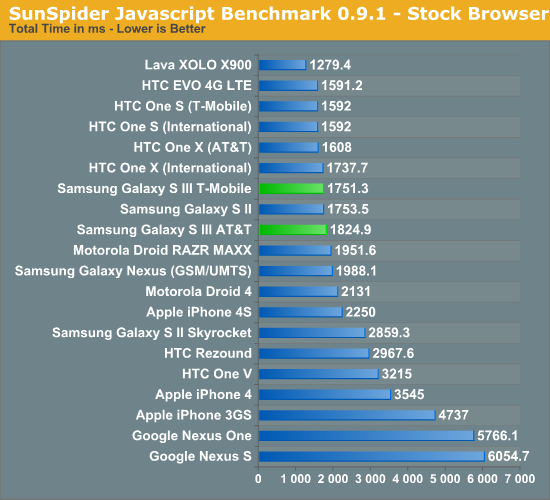
Like the other 1.5 GHz MSM8960 devices, the SGS3 does pretty well, but still is around 150ms slower. I ran this test multiple times but consistently got results in the 1750s or low 1800s for the SGS3s.
Browsermark is the next JavaScript test in our suite, and here it does very favorably against the rest of the competition.
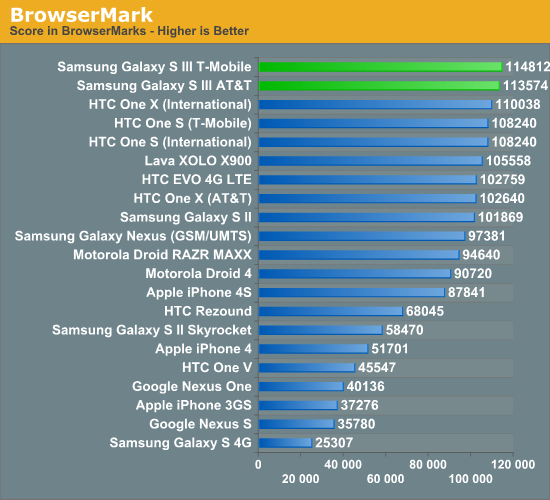
It’s interesting to see the SGS3 not do stellar in Sunspider, but excellent in Browsermark. Note that in our preview piece, I did see the International SGS3 post a score of 161k here.
Next up is Vellamo, which is a Qualcomm benchmark developed originally for OEMs to use and optimize their browser performance, and later released for general use. It’s a regular member of our test suite and includes both JavaScript tests and scrolling tests that stress the display composition and hardware acceleration in the browser.
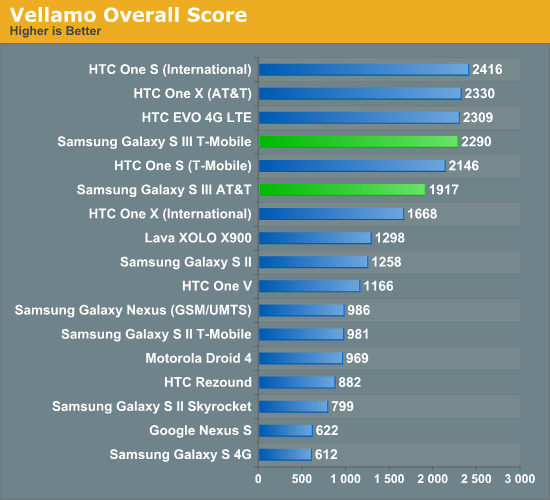
I saw an interesting deviation here between the AT&T and T-Mobile version, for reasons I cannot explain despite multiple reboots and making sure everything was closed. Either way, the devices both have stock browsers that feel like butter, absolutely smooth when translating or zooming around.
Low Level FP Performance
Linpack isn’t a great indication of overall smartphone performance, but it is a good test of the floating point capabilities of the CPUs in these SoCs. ARM has steadily been improving FP performance for the past few generations but we’re going to see a big jump to Krait/A15. As most client smartphone workloads are integer based and those that are FP heavy end up relying on the GPU, an advantage here doesn’t tell us much today (particularly because Linpack isn’t running native code but rather atop Dalvik) other than how speedy the FPUs are. There’s a new port of Linpack which runs using native code which we’ll be trying out in the big performance comparison piece.
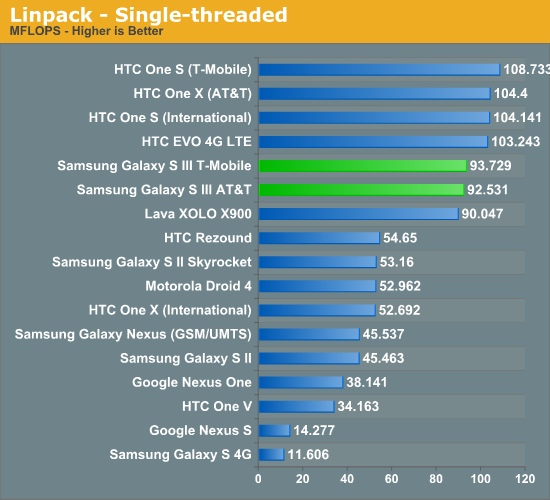
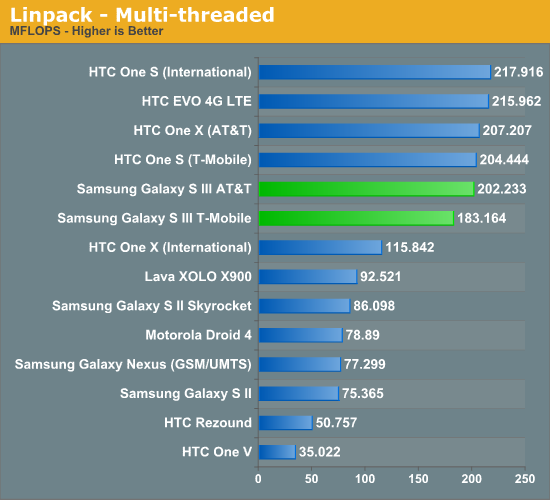
As we’ve shown before, FP performance on Krait is superb thanks to its architectural advantages over a straight A9. I find that FP performance was more relevant of a benchmark when display rendering was being done in CPU instead of on the GPU with the new OpenGL ES 2.0 render paths. Still, it’s worth talking about.
BaseMark OS
Rightware’s BaseMark OS is a general purpose benchmark designed to better simulate overall Android performance. It includes a heavily threaded benchmark, file IO tests, and compression/decompression tasks that all contribute to its overall score.
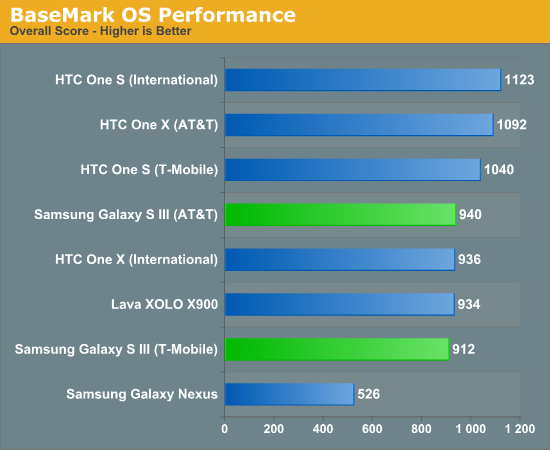
Basemark OS is relatively new to us but we’re adding more and more phones as time goes on for comparison purposes. Curiously enough the SGS3s post numbers a bit shy of their HTC cousins. I think that in spite of this, you’d be hard pressed to tell the Krait based One X and Krait based SGS3 apart.
GPU Performance - GLBenchmark 2.1
As we wait for actual 3D gaming benchmarks to make their way into Android (and hopefully crossplatform) games, we must rely on synthetic tests designed to simulate 3D game performance as best as possible. We start with GLBenchmark, one of the better Android GPU tests on the market today. There are two benchmarks, Egypt and Pro, and each is run in two modes: native screen resolution and offscreen (vsync disabled) at 720p. The latter is more useful for apples to apples comparisons as everything is rendering the same number of pixels, whereas performance in the onscreen tests is determined by the screen resolution of the device along with the performance of its GPU.
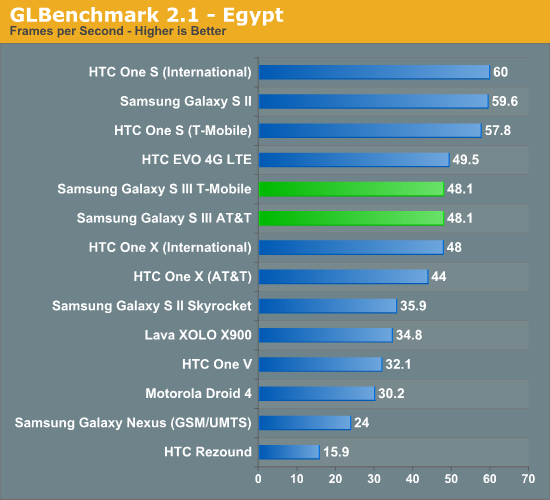
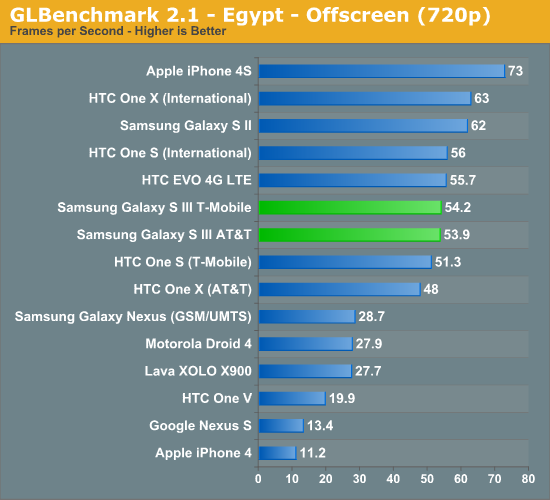
As a reminder, only the Egypt offscreen test takes place with vsync turned off, which is why you see devices with 720p displays posting different results on versus off screen where vsync is off. Part of the deal in getting Krait to market as quickly as possible required that Qualcomm pair the CPU with an older GPU, in this case the Adreno 225 instead of the newer Adreno 3xx offerings due out later this year in SoCs like MSM8960 Pro or the quad core Krait APQ8064. As a result, you can see the SGS2 with Exynos 4210 pull ahead in both tests. Obviously the on-screen test isn’t a totally fair comparison because of the inherent difference in resolution - 720p vs WVGA.
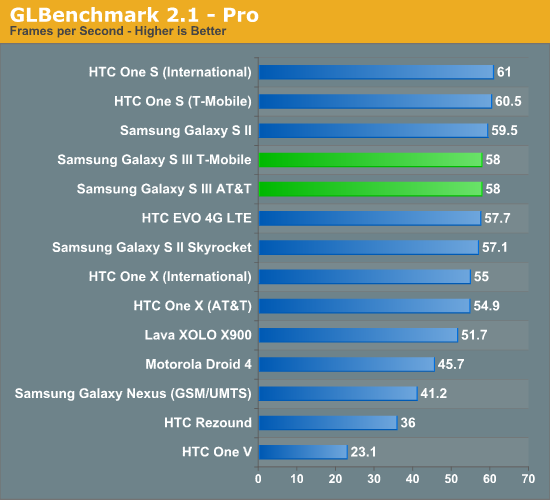
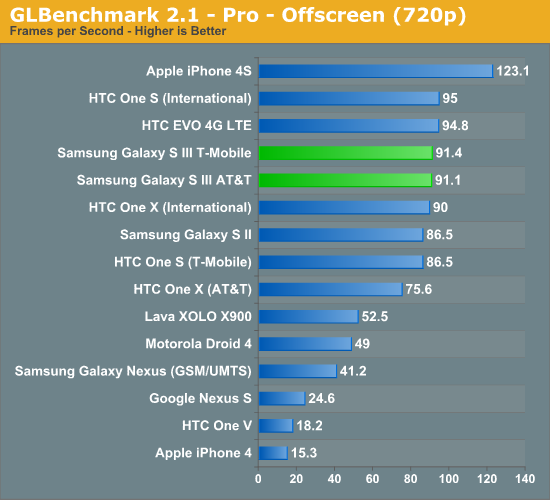
In the older Pro offscreen test, we see Adreno 225 trading spots with SGS2’s Mali–400 and coming out on top.
Basemark ES 2.0 V1
Rightware’s Basemark ES 2.0 V1 is an aging GPU test that tends to favor Qualcomm’s Adreno GPUs above almost all others:
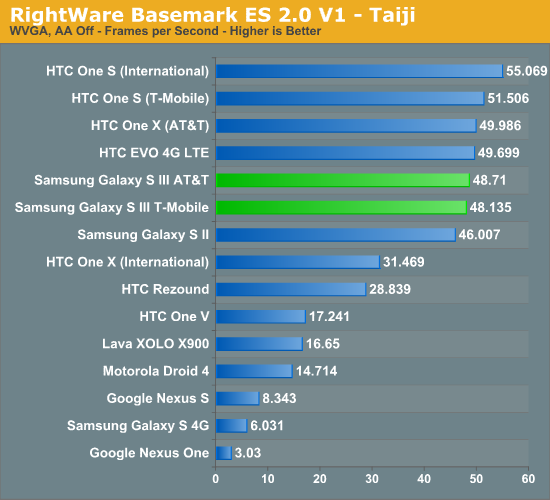
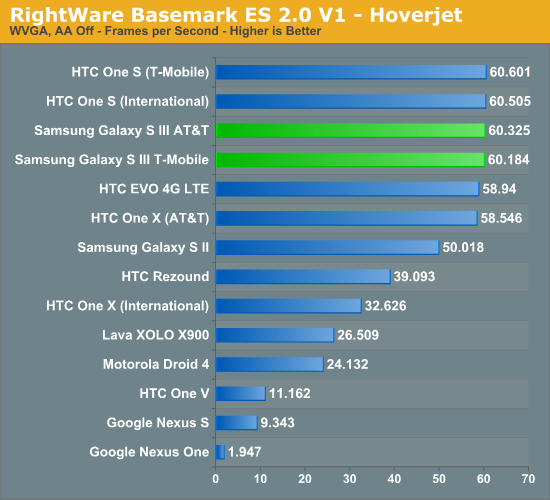
Basemark ES 2.0 is definitely starting to show its age, as Hoverjet is at vsync essentially the whole time, and Taiji is getting there as well. In addition, Qualcomm appears to be using ES 2.0 as an optimization target, so I wouldn’t put too much faith in the ES 2.0 results.


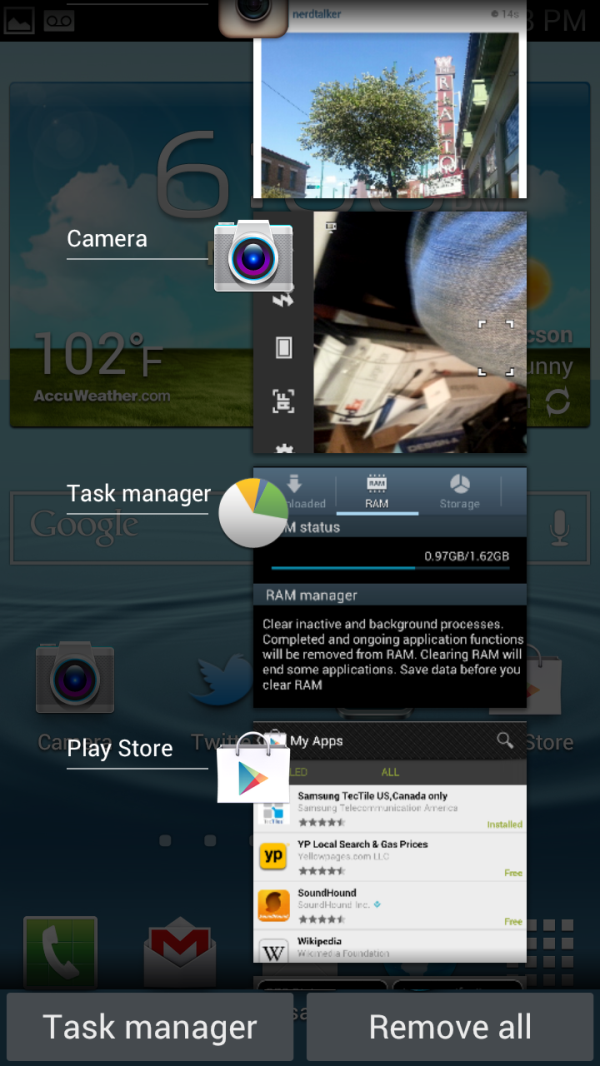
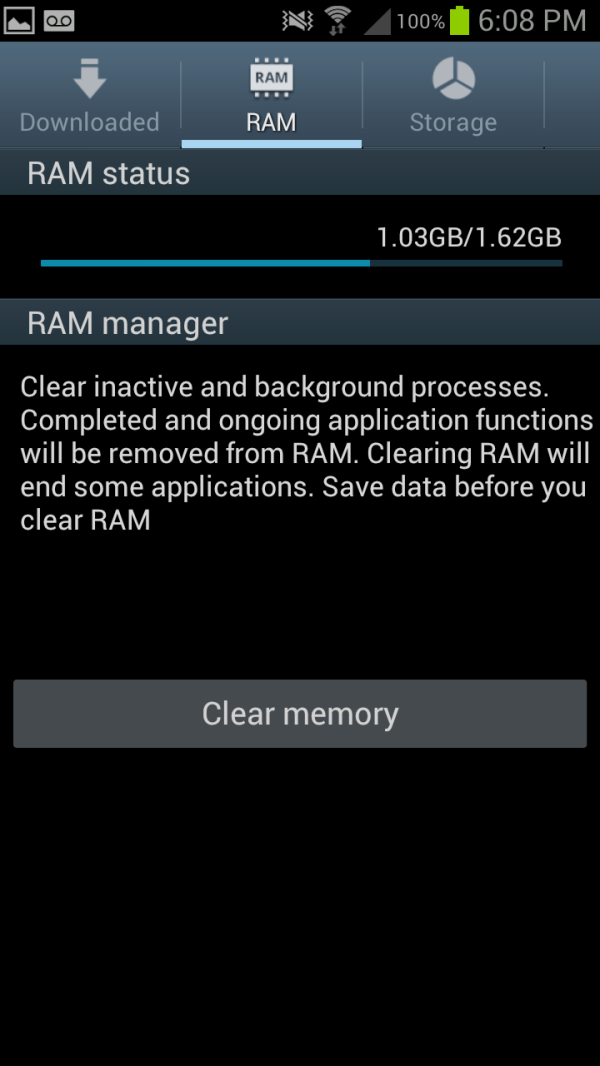








107 Comments
View All Comments
dijimoto - Wednesday, June 20, 2012 - link
I just realized it was in the title ICS version 4.0.4, ugh...EJ257 - Wednesday, June 20, 2012 - link
So does it use both GPS & GLONASS simultaneously? Or can you set a default and it'll switch over to the other system whenever signal from one of them gets to be too weak?Death666Angel - Wednesday, June 20, 2012 - link
I enjoyed it a lot. I like the fact that 1080p video isn't cropped anymore. My cropped SGS2 1080p doesn't look that good and I use 720p as a result.The screen looks good too and mostly I think the SGS3 looks pretty good. But for me, it's not enough to make the upgrade from my SGS2. I just bought a nice chinese tablet (Cube U30GT if anyone wonders) which will keep me happy for some time to come. I won't upgrade this generation. WVGA resolution, SAMOLED+, Mali GPU and good custom ROM support are all enough for me, for now. Maybe next year Intel will bring something new or Android 5/6 will change things. But right now, my SGS2 does everything I need it to do.
Maybe I didn't notice it, but I didn't see any references to bootloader/custom ROMs. For me, whether or not a phone is easily rooted, hacked etc. is an important part of my purchase decision. Maybe you can include a short discussion of that in the future? If you did mention it, I apologize. :-)
chiza69 - Wednesday, June 20, 2012 - link
I usually love your reviews Brian as they are often unique and give a different perspective compared to other tech sites. However, one thing that frustrates me, and is consistent in all your reviews is the performance category.All you do in this category is run benchmarks. Yes, benchmarks are always fun, but both the iPhone and most Windows Phones have proven that benchmarks do not make a system run smoothly. I mean look at the latest android phone, the Galaxy S3, with it's quadcore processor and top of the line GPU. Yes it is fast in benchmarks, but honestly it still cannot make Android as smooth as iOS.
All I would like to see is that you add a video of typical performance on the phone, especially with the browser.
name99 - Thursday, June 21, 2012 - link
"Clearly there is 380 MB absorbed for both preallocated GPU memory, and possibly DRM / baseband, and after that subtraction the only way to get dual channel (2x32b) LPDDR2 is to make the jump to two 1 GB LPDDR2 devices."I don't get this. Why can't you have a 1GiB and a 512MiB package? Are ARM memory controllers less sophisticated than Intel ones and unable to handle such a config? After all this sort of config is standard on Windows --- 3GiB back in the day when that was all Windows could handle, now 6GiB on your mid-range laptops that are too cheap to spring for 8GiB.
antony22 - Thursday, June 21, 2012 - link
well been waiting for some reviews of the GS3 I was going to get this or the EVO 4G lte on sprint but after a read the whole article I think I made my choice nowI cant believe that Samsung chose not to use the on board Wi-Fi and went with another chip when the on board is 28 nm while the BCM4334 is 45nm
when i was reading the battery life test I thought hmm that is odd that the HTC EVO has better life on wi- fi than the GS3 even when they use the same SOC now everything makes sense and also the GS3 is slower too on wi-fi
SanX - Thursday, June 21, 2012 - link
Brian,In the section about display pixel angular dimensions (0.933 arcmin) you have used word "pixel" while it is actually just the green subpixel angular size. BUT THAT IS WRONG! The largest problem is the red subpixels angular distance (and contrary to laws of physics much less blue). This gives dirty feel of solid colors of red part of spectrum and jagg of lines. THAT IS EXACTLY the main problem of the pentile displays. And that's red and blue distance TWO time larger the green one and of course IS visible very well - just place the screen of LG Nitro nearby.
Another problem is your 12 inch distance. Formally and practically the the optimal distance for reading is usually 10 inch (25 cm). This is also why in magnification of lens in physics 25cm is used. I typically take phone even closer - to 9". You barely stand pentile screens in this case.
We always forget, but ideally for proper scaling of small fonts, because we have digital, not analog screens, it's not a one pixel angular size must be unresolved by our eyes but around TWO stacked ones. That gives 600ppi requirement. Only after that we will not see visible difference (jumps) in line thickness when scale fonts.
Belard - Thursday, June 21, 2012 - link
So... with these current "smart" phones... do anyone of them have good enough speakers to actually wake a person up?That would be a NICE little added benchmark. How loud can the phone get.
I'm about to retire my SGS1... its speakerphone mode has always been garbage (being that it faced away from you) and the alarm itself has been pathetic. So bad, that I still us a 4 year old Sony dumb phone as wakeup alarm. Even when this stupid phone "rings", I miss half the calls because the speaker and its vibration are weak.
How about this... make phones that actually FEEL good in the hand, not some danty tablet-size thingy that you can barely hold onto with your finger tips that doesn't FIT in a pocket. Sure, its fine for those who wear a purse and it seems some guys are wearing purses or bags... that's fine.
But many of us guys put the phones in OUR pockets where there is money, wallets, keys and whatever.
The SGS1 was already too damn big to comfortly fit into a pocket... the S3 and now bigger S3 should just make it much worse.
Eridanus - Thursday, June 21, 2012 - link
SD card slot? So they screwed up only customers of their Nexus crap?apoorvnaik - Thursday, June 21, 2012 - link
As seen in your post, you say that a T-Mobile SGS3 will work on AT&T's network also but the specs on the T-Mobile's page say something else.Here's the link to the T-Mobile page
http://www.t-mobile.com/shop/Phones/cell-phone-det...
I'm looking forward to buy this phone and just wanted to make sure that it could be used worldwide.